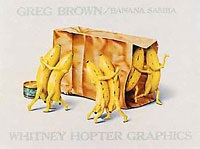|
"We have old-fashioned tomahto, Long Island potahto, but, Yes, we have no bananas. We have no bananas today." . . . Folk song by Frank Silver and Irving Cohen (1923)
Whether you are off to Rio following the colorful trail of Carmen Miranda’s fruit-filled hat or seated on your couch contemplating the universe, the banana can always come along for the ride. There are so many aspects to this strange and wonderful fruit. Even its shape is a bit mysterious; conjuring images of tropical islands and sun-filled days. Did you know that the word "banana" originates from the Arabic and means finger? Doesn’t that make you wonder where the rest of the hand is? I have been hooked on bananas ever since I was a child, and Miss Chiquita, drawn by Dik Brown who also created the Campbell kids, used to sing to me through the television in my parents’ living room. (I always wondered why she never had her own show. She was so much cuter than Ed Sullivan.) You remember her words:
I’m Chiquita Banana and I’m here to say
Bananas need to ripen in a special way
When they are flecked with brown and have a golden hue
Bananas taste the best and are the best for you.
The banana is so popular in America today that four million tons of them are imported every year. Not to compare apples to oranges, but rather apples to bananas, a banana has less water, fifty percent more food energy, four times the protein, half the fat, twice the carbohydrate, almost three times the phosphorus, five times the Vitamin C and iron and at least twice the other vitamins and minerals as a single apple! The average American eats 33 pounds of bananas a year. An excellent source of potassium and carbohydrates, they can be eaten any time of the day because of their digestive properties. Natural sugar provides energy for those sports requiring endurance and low proportions of sodium chloridium render a good recommendation for salt free diets.
You can buy this Art print
at AllPosters.com

Banana Samba
by Greg Brown
26 in x 19 in
|
That’s all quite impressive, I know, but where did the banana come from in the first place? Did it arrive as a conundrum along with the chicken or the egg, or did both of them precede it? Buddhist texts from 600bc mention the banana for the first time in history. Alexander The Great tasted bananas in the Indus Valley in 327bc and in his day they were called pala. China records the presence of banana plantations as far back as 200ad (way before the birth of Scarlet O’Hara). In 650ad Islamic conquerors brought bananas back to Palestine and through trade spread them all over Africa. They were unknown to the New World until 1516 when the first root stocks were brought here by Spanish missionary, Father Tomas de Berlanger.
So much for traveling. How do they grow? The whole matter is extremely confusing. The banana tree itself (even though it is not a tree but a giant plant) is by definition an herb. What is an herb? Without passing go or collecting $200, the answer is a flowering plant with a fleshy, rather than woody, stem. Each stem consists of ten to fourteen hands, each carrying from eighteen to twenty bananas. The stem, however is a false one, formed by tightly wrapped overlapping leaves, resembling stalks of celery. The plant belongs to the same family as lilies, orchids and palms and the fruit is a berry. By definition, a berry is a simple fruit having a skin surrounding one or more seeds in a fleshy pulp. A banana cut lengthwise will reveal very tiny black seeds within its center. Therefore, a banana is a fruit, herb, berry and plant all at the same time. The expression "going bananas" probably came into vogue during the time all of these terms were being defined, don’t you think?
There are about four hundred different varieties of this fabulous fruit, but don’t tell Carmen Miranda. (Apart from the fact that she is dead and you couldn’t possibly, there is no way the woman could fit one more piece of anything on top of one of her hats!) The three chief imported brands are Chiquita, Bonita and Fyffes. The Chiquita (according to her whom I trust implicitly) is always a guarantee of quality. Its production sites are located in Honduras, Panama, Costa Rica and Columbia. The Bonita banana hails from Ecuador and is the cheapest of the three, but only because it is never advertised. Fyffe’s, founded in 1888, has the distinction of being the oldest fruit brand in the world. These bananas are produced in Belize, Columbia, Honduras, Suriname, Jamaica and The Windward Islands.
|